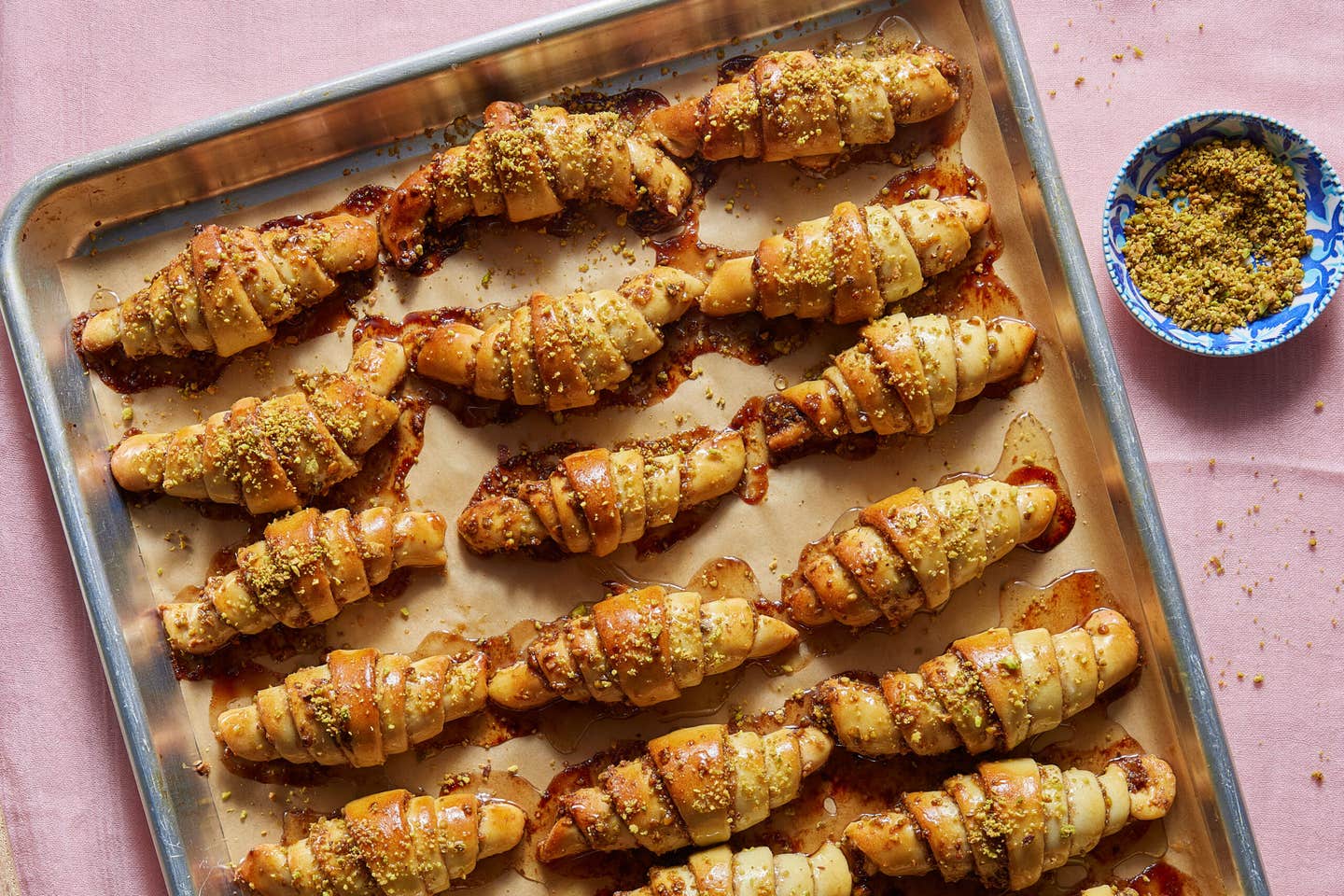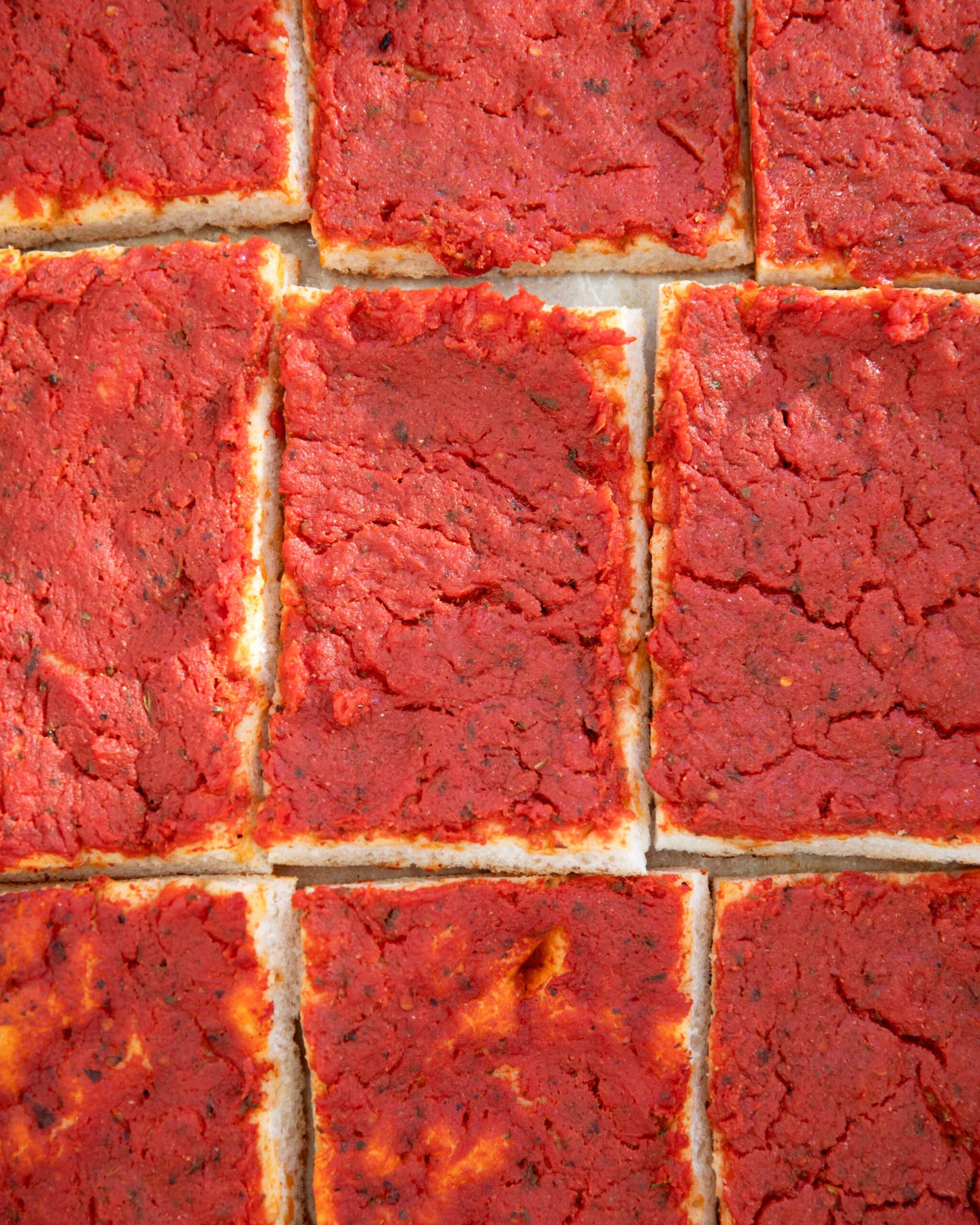Pistachio-Date Rugelach with Rosewater Honey
Middle Eastern flavors shine in Eitan Bernath’s Israeli-style recipe.
- Serves
48 rugelach
- Time
1 hour 25 minutes

The most quintessential part of every weekend in my childhood home (at least, culinarily speaking) was rugelach. The dough was super thin and light, almost babka-like, and rolled into a tiny croissant shape. The traditional fillings were never overly sweet; warm and earthy cinnamon was balanced with just a touch of sugar; chocolate was always semisweet, never cloying. These were the perfect two-to-three bite treat at the end of our family’s Shabbat meal, a little afternoon pick-me-up or, dare I say, a late night snack.
Rugelach are a traditional Jewish pastry, with roots in a variety of Eastern European baked goods, like Hungarian kifli and Polish rogal. Early rugelach were likely made with a yeasted dough, and filled, much like today, with jam, poppy seed paste, or nuts. Eventually, rugelach made their way to the U.S., and American bakers adapted the old recipe for speed. They replaced the slow-moving yeast pastry with a cream-cheese based one that’s more similar to pie dough. American-style rugelach are now more or less defined by this rich and crumbly dough, which requires no kneading or rising time, and which removes at least a full hour from the old process. And while these are perfectly delicious, they aren’t the rugelach I crave.
Since these pastries were such an important part of my childhood, once I started cooking and baking, they were one of the first things I wanted to learn how to make. I quickly realized that the vast majority of the recipes online are nothing like the versions I grew up eating. After exhaustive research into the pastry’s history, I solved this mystery: I had grown up eating yeasted Israeli-style rugelach, while most of the recipes published here in the U.S. are, of course, American-style.
Once I figured that out, it didn’t take too much work for me to adapt my babka dough to create a classic, Israeli-style rugelach. I also spiced up the traditional fillings with some of my favorite Middle Eastern flavors that I think pair beautifully: toasted pistachios, date syrup, honey, rose water, cardamom, and cinnamon. (Rest assured—if you prefer simpler flavors, this dough also works just as well with cinnamon and honey.) In my humble opinion, the resulting rugelach are just as delicious as any I’ve had from a bakery.
Ingredients
For the dough:
- 1 tsp. instant dry yeast
- ¾ cup whole milk, slightly warmed
- 3¾ cups all-purpose flour, plus more as needed
- ⅓ cup sugar
- ½ tsp. kosher salt
- 2 large eggs, at room temperature, lightly beaten
- ⅓ cup vegetable oil, plus more for greasing
For the filling:
- 1½ cups shelled unsalted pistachios
- ¾ cup sugar
- 1 tsp. cinnamon
- 1 tsp. kosher salt
- ½ tsp. ground cardamom
- ½ cup date syrup, divided
For finishing:
- 1 large egg, at room temperature, well beaten
- ¼ cup honey
- 1 tsp. rosewater
Instructions
Step 1
Step 2
Step 3
Step 4
Step 5
Step 6
Step 7
Step 8
- In the bowl of a stand mixer fitted with a dough hook, stir together the yeast and milk. In a medium bowl, whisk together the flour, sugar and salt, then transfer the dry ingredients to the yeast mixture. Add the eggs and oil, then mix on medium speed until the ingredients are just combined, about 1 minute. Scrape down the sides of the bowl, then continue mixing on medium speed until a smooth dough forms and pulls away from sides (but not the bottom) of the bowl, about 5 minutes. If dough seems very wet, add flour 1 tablespoon at a time, mixing well between additions, until it cleans the sides of the bowl.
- Lightly oil a large, clean bowl, then transfer the dough into it. Cover tightly with plastic wrap, and place in a warm place until the dough has doubled in size, about 1 hour.
- Meanwhile, make the filling. To a small, dry skillet over medium low heat, add the pistachios and cook, tossing frequently, until fragrant and toasted, 5–6 minutes. Transfer to a food processor and pulse until very finely ground (about the size of breadcrumbs), about 45 seconds. Measure a tablespoon of the ground pistachio and set aside for garnish; transfer the rest to a medium bowl, then stir in the sugar, cinnamon, cardamom, and salt. Set aside.
- Once dough has risen, preheat the oven to 350°F. Position two oven racks in the top and bottom third of the oven. Line 2 large sheet pans with parchment paper and set aside.
- Lightly flour a clean work surface and transfer the dough out onto it. Divide the dough in half, set one half aside and cover with a tea towel. Using a lightly floured rolling pin, roll the other half out to an even circle, approximately 20 inches in diameter and ⅛ inch thick. (The dough should be very thin and nearly transparent.) Using an offset spatula or the back of a spoon, spread ¼ cup of the date syrup evenly over the dough, all the way to the edges, then sprinkle half the pistachio mixture evenly over top. Using a pizza cutter or large knife, cut the circle into 24 even wedges. Starting at the outer edge of each wedge, roll the dough into snug spirals, maintaining tension by gently pulling towards the outer part of the circle as you roll. (The final shape should look like a mini croissant.)
- Place the rugelach, pointed-end-down, on one of the baking sheets, leaving them about 2 inches apart. Brush the tops lightly with egg wash and bake, rotating the sheet once halfway through cooking, until golden brown, 15–18 minutes.
- While the first batch of rugelach bakes, repeat the process with the second half of dough and filling.
- Finally, make the rosewater honey: To a small, heatproof bowl, add the honey and microwave just until liquidy, about 30 seconds. Stir in the rosewater and set aside. Remove the rugelach from the oven, immediately brush with the warm rosewater honey, then sprinkle lightly with reserved pistachios. Serve warm or at room temperature. Stored in an airtight container, leftovers keep well for up to three days. (If you enjoy the flavor of rosewater and are eating the rugelach after the first day, you may top with a second layer of glaze just before serving.)
Note:
If you prefer to make a classic cinnamon rugelach, leave out the pistachio-date filling. Onto each half of dough spread 4 tablespoons of softened unsalted butter then top with a mixture of 1 cup brown sugar and 2 tablespoons ground cinnamon. Shape and bake as above, omitting the honey glaze and pistachio garnish.
Keep Reading
Continue to Next Story










